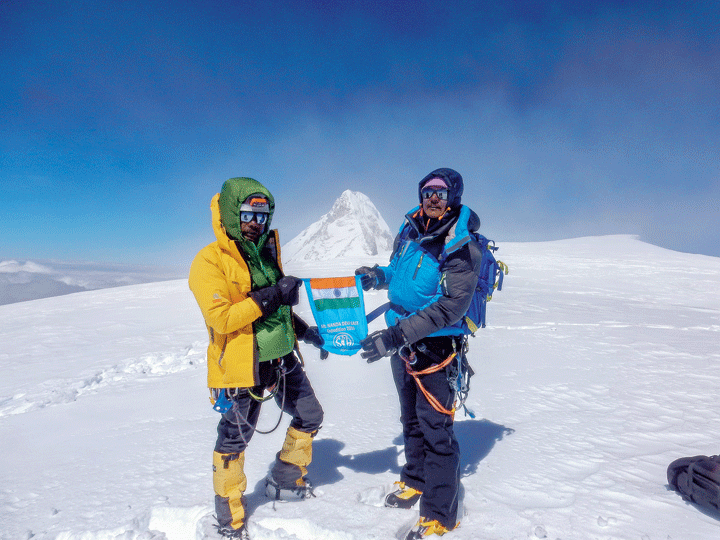September 15 was a Sunday. Around the time Calcuttans were gearing up for festive shopping after a late breakfast, a team from the city and its outskirts conquered a 24,000ft Himalayan peak that Tenzing Norgay had counted among his toughest climbs.
The team that conquered Nanda Devi East, which stands at 7,434 metres (24,390 ft), comprised a data analyst with a multinational bank, an assistant professor at Presidency University and two businessmen. The members of the South Calcutta Trekkers Association were accompanied by five sherpas. Their climb is being hailed as the first Indian civilian team’s ascent to the peak.
The final leg of the summit got particularly tense because of shortage of climbing ropes. The summit team had to be as small, light and fast as possible. It was decided that one of the climbers would go for the summit and the others would remain stationed at strategic lower points to intervene if things went wrong.
Pradip Bar, a 34-year-old distributor of CCTV cameras in Howrah, scaled the peak around 10.36am, along with four sherpas.
“The expedition was a story of passion, grit and team spirit. Pradip went to the summit, but the climb was made possible by the team,” said Rajsekhar Maity, the 42-year-old leader of the expedition who works in the analytics division of a London-headquartered MNC bank. Upal Chakrabarti, 36, who teaches sociology at Presidency University, and Ashish Gupta, 36, a trader of mobile handsets in Howrah, were the remaining members of the team.
The Indian Mountaineering Foundation’s newsletter for October has a feature on the expedition.
Peak of challenges
Nanda Devi East is the sister mountain of Nanda Devi (25,643ft), India’s second-highest peak in Uttarakhand’s Garhwal Himalayas. A Polish expedition scaled Nanda Devi East for the first time in 1939. But it has only been scaled two times out of a dozen attempts in the past two decades, according to the archives of the IMF.
In May this year, an eight-member international mountaineering team led by British mountaineer Martin Moran was swept away in an avalanche while on their way to Nanda Devi East. While the bodies of seven members of the team were retrieved by the Indo-Tibetan Border Police, Moran’s body could not be found.
Extremely unpredictable weather, the brittle nature of the rock and razor-sharp ridges with drops of 3,000ft on either sides are some of the factors that make Nanda Devi East one of the most challenging peaks in the Himalayas.
“The terrible cold and howling winds were the biggest challenge. At 20,000ft, if the temperature is -15°C, winds blowing at 35kmph make it feel like -30°C. Regardless of the gear you are covered in, the air that you breathe is piercingly cold,” said Chakrabarti.
The journey
The entire journey from Calcutta and back took 43 days. The team started the trek from Lilam, near Munsiyari, on August 20 and reached the base camp at 14,000ft after six days. The first major challenge was a non-stop climb of 3,300ft in one day from the advanced base camp through a couloir (a steep, narrow gully) of brittle and loose rock and think layers snow to reach the first stop — Camp 1, also known as Longstaff’s Col.
“Between the advanced base and Longstaff’s Col, there is no place to camp. So, there is only one way — non-stop climb till you reach Longstaff’s Col,” said Maity.
The journey from the Base camp to Camp 1 took 13 days, of which 11 were spent in ferrying luggage — food, fuel and equipment — and opening routes with pitons, ropes and other equipment between lower and higher reaches. The actual climb took two days.
This drill continued for the remaining climb. The combined weight carried by the team by 800kg. The brittle and flaky nature of the rocks meant the team had to drive triple the number of pitons into a rock or crack to support a rope. Between Camp 1 and Camp 5, the team spent nine nights in camps on razor-sharp unstable, narrow and exposed ridges with a free fall of over 3,000ft on either side.
Two members and five sherpas — the remaining members were camped at lower points to manage any eventuality — camped at Camp 5 (the penultimate stop) at an altitude of 22,600ft on September 14.
Final ascent
Around 1.30am on September 15, Pradip Bar and four sherpas stepped out for the summit. After sunrise, the wind got fiercer and clocked a speed of over 40kmph.
“On three occasions, when the wind speed increased, we thought of turning back but later decided to wait and let it pass,” said Bar.
After negotiating a long wall of rock just before the summit, the team found a small cornice blocking their way. That had to be broken before Bar could put his first step on the vast summit field at 10.36am. The wind speed, by then, had clocked 50kmph.
“But the sky above was clear. From where we stood, only one thing was higher — the main Nanda Devi peak on our west,” said Bar.
Not a tourist peak
“Unlike Mount Everest, Nanda Devi East is not a popular and crowded peak where a lot of facilities are available,” said Sumit Day, a veteran climber from South Calcutta Trekkers Association.
“Our team members had to do it all by themselves. The ascent of Nanda Devi East is a shining triumph of the spirit of mountaineering,” he said.
IMF president Col H.S. Chauhan said it was not fair to compare the two peaks. “Nanda Devi East is a reasonably good technical peak. Their ascent is commendable,” he said.











